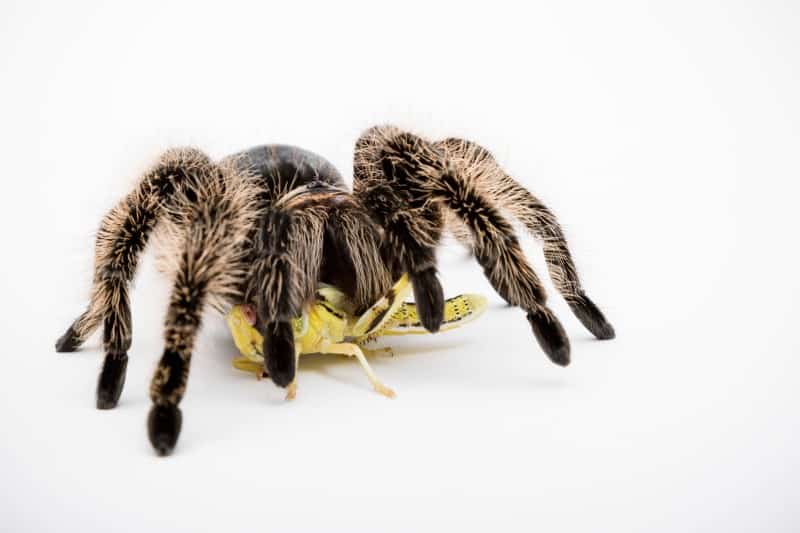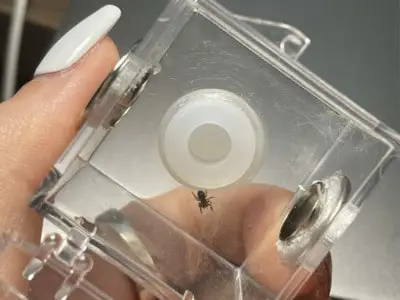Many factors determine the health and well-being of tarantulas. One of which is the food they are eating.
Feeding tarantulas a high-quality and nutritious diet will ultimately result in healthier and happier pet tarantulas. And giving them low-quality food is nothing but a recipe for trouble.
So it is completely normal, if not highly recommended, for owners to look for the best places to buy feeders. In this article, I will go over everything you need to know about buying feeders for your tarantulas, what to look for, and whether to buy them from.

Best Place to Buy Feeders for Tarantulas
Rainbow mealworms
Rainbow mealworms is an online seller that specializes in feeders. On their website, you will find an excellent selection of feeders like hornworms, mealworms, superworms, phoenix worms, rice flour beetles, roaches, flightless fruit flies, mantises, and so much more.
All deliveries are usually timely, and the feeders come well packed. Many enthusiasts often order large quantities of feeders as they are always very lively and healthy.
On top of that, there is also extra information on their website on how to properly take care of the feeders.
The prices are excellent, too. Overall an excellent seller that does not disappoint.
Josh’s Frogs
Don’t allow yourself to be tricked by the name. Although they do sell reptiles and frogs, Josh’s Frogs also sells feeders.
In fact, on their website, you will find a very good selection of different feeders like hornworms, super worms, mealworms, house flies, crickets, roaches, and beetles.
Ovipost
Ovipost sells mostly crickets, superworms, and Discoid roaches. The quality of the feeders is excellent, and they are offered at very fair prices.
Overall, Ovipost is one very good seller that is worth checking out if you are looking for a good place to buy your feeders from.
The Critter Depot
The Critter Depot is another retailer that is well-known and trusted in the community. They have a good selection of feeders like live crickets, Dubias, and superworms.
Their website is structured in a very user-friendly way making navigation easy. Everything is usually kept up to date and clearly labeled. Feeders are always packed well, ensuring their safety during transport.
Mulberry Farms
Mulberry Farms is one of the reputable sellers that are worth keeping in mind.
Their prices are reasonable, and they have a good selection of feeders. Superworms, silkworms, hornworms, mealworms, waxworms, roaches, crickets, and butterflies can typically be found on their website.
Cape Cod Roaches
If you are looking for a place that sells different roaches like Dubias and Red Runners, Cape Cod Roaches is easily one of the top sellers.
The prices are very good, and each package is packed well and professionally.
Jamie’s Tarantulas
Jamie has built a reputation for herself that precedes her. She is a trusted online vendor that specializes in selling tarantulas and tarantula supplies. However, on her website, you will discover she also sells feeders.
There isn’t a great selection, though. Jamie has been selling some of the more common types of feeders like the Blatta lateralis, Blaptica dubia, and even some beetles, but lately, she’s been selling mostly B. lateralis.
On her website, you will also find some feeder supplies like plastic boxes, egg crate flats, water crystals, and roach chow.
The prices are very fair, and communication with Jamie has always been on point.
Swift’s Invertebrates
Swift’s Invertebrates is one of the go-to places when it comes to buying tarantulas online. However, on Swift’s website, you can also find some feeders. There isn’t a great selection as he focuses mainly on roaches. Nonetheless, it is one of the places hobbyists can consider.
Net-Bug
Net-Bug is another website worth checking. Anastacia at Net-Bug has been selling mostly flightless fruit flies (FFF) and a small selection of beetles and roaches.
The website is kept up to date and very well structured, so finding what you need is not a difficult task.
Anastacia is a trusted online retailer and has proven to be very passionate, professional, and easy to communicate with.
Ken The Bug Guy
Ken is another online seller that is well-known in the community when it comes to buying tarantulas online.
He has always been very professional and consistent in his approach and communication, so he is definitely among the top online retailers. He used to sell feeders, too, offering wax worms, mealworms, super worms, and Dubia roaches. Lately, however, the feeders section on his website has remained empty. Nonetheless, keeping Ken in mind is still worth doing.
Fishing Bait Dealers and Pet Stores
The easiest place to buy feeders from is your local pet stores, exotic reptile shops, and fishing bait shops. Most of these stores sell a selection of different live feeders that you can use for your tarantulas.
The upside to buying your feeders from a local store is the fact that you are buying locally, and you will not have to worry about deliveries.
There can be some downsides to buying from a local store. First, not all hobbyists will have local pet stores nearby. And second, feeders may not be treated well, and their living conditions may be very poor.
Forums and Other Sites
It is always worth checking the local popular forums and websites where people caring for tarantulas may gather and exchange information. Often there can be classifieds sections and threads, where people who are selling not just tarantulas and equipment but also feeders can be found.
If you are based in the USA, Arachnoboards is probably one of the websites you should check first. Checking out the Arachnoboards’ classifieds section is worth doing as people are often selling feeders there.
The marketplace section on Tarantulaforum.com is another place where some good deals can be found, although people there are usually selling tarantulas.
For people living in the UK, Reptileforums.co.uk is worth checking and keeping an eye on. Reptileforums.co.uk has a dedicated classifieds section on feeders where people buying or selling feeders can be found.
Feeders can also be found on eBay and Amazon.
Where to Buy Feeders Online List
Now, if you are still interested in exploring more places where you can buy feeders online or are simply interested in an easy to browse list, below I have included a neat list of the most commonly used online feeder breeders enthusiasts have been using over the years.
As a little disclaimer, though, I’d like to mention that this is by no means a comprehensive list of all breeders. Breeders, much like other businesses, come and go. These are either the breeders who have built a reputation for themselves or those who have been working for many years. That being said, I do my best to keep the list as up-to-date as possible, but changes can and most likely will happen in the future.
Where to Buy Feeders Online in the USA
- Rainbow Mealworms
- Josh’s Frogs
- Mulberry Farms
- Jamie’s Tarantulas
- Ovipost
- Cape Cod Roaches
- The Critter Depot
- Swift’s Invertebrates
- Net-Bug
- Ken The Bug Guy
- Dubia Roaches
- Symton Black Soldier Fly
- Roach Crossing
- Great Lakes Hornworm
- Linda’s Gone Buggie
- Ken The Bug Guy
- Snailtail
- Coastal Silkworms
- Ghann
- Reptile Food
- Millbrook Crickets
- Buy Dubia Roaches
- The Fruit Fly Shop
- Mantis Place
- AB Dragons
- Fluker Farms
Where to Buy Feeders Online in Canada
Where to Buy Feeders Online in the UK
What Are the Best Feeders for Tarantulas to Buy
Most hobbyists will find that one of the problems with tarantulas is that there aren’t many staple foods they can choose from. On top of that, nearly all types of feeders have some downsides to them.
Crickets
Crickets are possibly the most common type of feeder hobbyists use. If anything can be considered a staple food in the tarantula keeper’s world, it would be cricket. Grasshoppers and locusts are also used.
Crickets are widely available, come in many different sizes, and are not invasive if allowed to escape.
That being said, crickets do have their downsides. They tend to die easily and cannibalize each other even if kept well fed. Adult crickets can also start chirping, and many enthusiasts will not appreciate the constant noise they make. If left in the tarantula’s enclosure, they can actually bite and injure molting tarantulas. Crickets can also bury, and last but not least, they tend to smell.
Roaches
Roaches, contrary to what some may believe, are very clean. They do not smell and do not make noises—which is why they are so popular among enthusiasts. The most commonly used roaches are Dubia roaches and B. Lateralis roaches.
They are great feeders that are also very easy to raise since they don’t require a lot of care. They are silent and not dangerous to the tarantula.
Many hobbyists like the B. lateralis roaches because they tend to be very active and do not bury or harm your tarantula.
Dubias are also a staple food for many tarantulas since they, too, do not smell, make any noises. They are easy to look after, breed, and also tend to be very cheap.
The biggest downside to roaches is that they can be very invasive if they escape the tarantula’s enclosure and are usually found in online stores.
Worms
Worms—waxworms, phoenix worms, super worms, and especially mealworms—are also staple foods. Tarantulas can also be fed earthworms. However, earthworms may contain high amounts of pesticides depending on where and how they have been raised.
Superworms are an excellent choice for larger species and a perfect alternative to pinkie mice.
Super worms and mealworms can molt into beetles that can be fairly dangerous to molting tarantulas. Beetles also do not offer a lot of nutrition and tend to bury, which can be a problem.
Worms, in general, are available in many stores, do not have any strong odors, and are easy to keep and raise.
What Feeders You Should Avoid Buying
Tarantulas—both wild and indoor-bred—can be considered opportunistic feeders since they will feed on nearly anything they can catch and overpower.
That being said, this does not immediately mean owners can feed them everything.
Any feeders or other foods that may have been in contact with pesticides, fertilizers, other potentially toxic chemicals, or medications should be avoided. All of these can turn a seemingly harmless food into something that can kill a tarantula.
Bees and wasps should not be given to tarantulas. They are dangerous and contain harmful substances. Even a dead wasp can potentially hurt a tarantula.
Ants are also not recommended. Most ants contain formic acid. Some can even spray it or deliver painful stings. In fact, ants can be so dangerous that a tarantula will leave its burrow if ants invade it.
Keepers should avoid giving particularly large and tough insects like lubber grasshoppers, stag beetles, or large mice and rats to their tarantulas. These animals can be pretty challenging even for a fully grown tarantula and can injure it.
Keepers should also keep in mind that particularly large feeders, in general, can be dangerous and hurt a smaller tarantula. A good rule of thumb to follow is to feed tarantulas only feeders that are no larger than their abdomen.
Lastly, commercially raised feeders have not always been raised on an optimal diet providing them with plenty of nutrients, vitamins, and minerals. Consequently, tarantula owners will choose to gut load the feeders before giving them to their tarantulas.
Enthusiasts caring for larger species will often feed them small mice and rats. This is generally considered okay. However, they usually leave a nasty mess to clean afterward and can be a very gruesome sight.
How Many Feeders You Should Buy
Now come some of the tricky questions that many enthusiasts will have, namely, “How much food is too much for a tarantula?” and “How much food should I buy?”
To determine how many feeders you should buy, you need to consider your tarantula’s feeding behavior, needs, activity level, prey size and type, and tarantula’s abdomen size. How often and how much tarantulas eat, of course, varies depending on their species and stage of development.
There is no one size fits all solution here, and keepers should be aware of that and be ready to adjust on the spot.
For example,
- Slings usually feed more often, so providing them a small prey 2 to 3 times a week is not uncommon.
- On the other hand, juvenile tarantulas do not have to be fed as often, and many enthusiasts will feed them 1 to 2 times every one to two weeks.
- Lastly, adult tarantulas will differ in their feeding habit and requirements depending on their species. Some may thrive on 2 to 4 crickets or roaches a month, while others may eat through them in a single day. On the other hand, superworms can be a hefty meal, meaning 1 superworm is more than enough for a whole week.
The lifespan of crickets is about 6 to 8 weeks. If you are buying medium or large crickets, they may last 2 to 3 weeks only. This is why usually crickets are best bought in small quantities (5 to 8) from local pet stores and shops.
Roaches, on the other hand, live between 18 to 24 months. Roaches are easier to keep, so buying a few dozen roaches can be a good way to go about it.
Worms, depending on their species, can live anywhere between 2 weeks up to 2 years.
Also, it is important to keep in mind the importance of having a variety in the tarantula’s diet. In the wild, a tarantula is more than likely to feed on a wide variety of prey, so keepers are recommended to provide their tarantulas with some variety as well.
However, tarantulas are known sometimes to refuse to eat particular types of feeders or refuse to eat at all. As long as the tarantula seems to be in good health, this is not necessarily a cause for concern, as some tarantulas can go through long periods of fasting.
If you are looking to start a colony, you will need a higher number of feeders. For example, to start a Dubia colony, you may need to get about 50 to 100 or so roaches, and to start a mealworm colony, you may need between 100 and 150 mealworms.
Buying feeders vs. maintaining a colony
At this point, some of you may be wondering whether or not there are better alternatives to constantly buying feeders for your tarantula. After all, bugs, crickets, roaches, and all sorts of worms can be easily found and caught outside.
Here’s the thing, though.
It is not recommended to feed tarantulas with wild-caught feeders from the outside. Wild-caught feeders may have been in contact with pesticides and herbicides, which can pass down to your tarantula. They can also be carrying a disease, which can also be dangerous for the tarantulas.
Since the risk is usually not worth it, most keepers are left with one choice—to use captive-bred feeders.
Generally, captive-bred feeders are used because they are raised in a controlled environment free of disease and toxic chemicals and substances.
Now, this gives tarantula owners two options: (1) to buy their feeders or (2) to breed their own feeders, maintaining a colony.
People who do not have many tarantulas prefer to buy their feeders. This is more efficient, but buying small quantities of feeders is generally more expensive.
Raising feeders is worth doing only to people who have large collections of tarantulas or live in an area with particularly bad and cold weather where access to feeders or their delivery may be impossible.
Maintaining a feeder colony is very time-consuming and laborious.
The only option for some keepers is to buy their feeders online. To keep expenses down, their best option is to go for mealworms that can be bought in higher quantities (50) and be stored dormant in a fridge for long periods.
Read more: Where to Buy Tarantula Online








